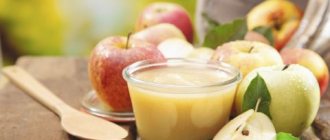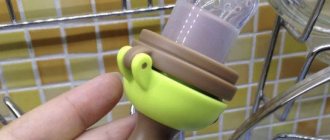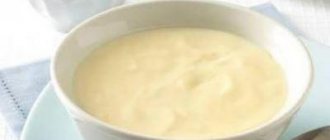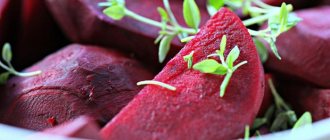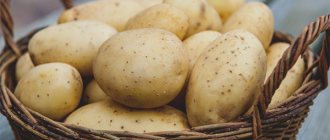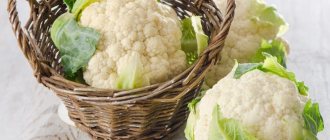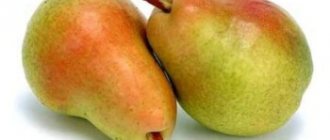The first six months have flown by, and now the caring mother begins to consult with specialists, listen to the advice of experienced women, or surf the Internet in search of information about methods and types of complementary feeding.
The list of products [1] permitted for complementary feeding is strictly limited. All this is connected with the sensitive digestive system of the little man. But the baby’s nutrition should be complete, balanced and healthy. You need to start with vegetable purees. Is pumpkin suitable for complementary feeding?
Rules for introducing complementary feeding with pumpkin
Despite all the benefits of the vegetable, it, like all other new products, is introduced into the baby’s menu according to specially developed rules.
- The first portion is 3-5 g of homogeneous puree, or you can give a small, well-cooked piece the size of a grain of rice.
- A new product is introduced if the baby has not tried anything else over the last 2-3 days.
- Strictly one new product is introduced, otherwise it will be difficult to identify what caused the allergic reaction or interruptions in the gastrointestinal tract in the infant.
- It should be given in the first half of the day. Afterwards, during this day and the next two, observe the reaction of the baby’s body.
- If there is no negative reaction, the serving size is gradually increased to 40 g per day.
- In case of allergic manifestations or digestive disorders, feeding pumpkin should be postponed.
- It is not recommended to introduce complementary foods during illness or after vaccination.
At what age can it be administered?
From what months is it allowed to introduce pumpkin into complementary foods? Breastfeeding experts recommend giving your baby zucchini and cauliflower first. And only then, from seven months, begin to accustom him to pumpkin. The fact is that the bright color and pleasant taste will discourage the baby from eating neutral vegetables in the form of zucchini or cauliflower.
How often can you give pumpkin?
From seven months, if the baby’s body has responded well to complementary foods, pumpkin is given 30 g 1-2 times a week. The single volume increases gradually, starting with a small dose. Closer to the year, the portion is 30 g three times during the week. After a year, the norm increases to 50 g.
Recipe 2: Mannik with sour cream
Mannik with sour cream is not only very tender and tasty, but it always succeeds. In this recipe, the quantities indicated are for a standard cake pan. If you double the ingredients, the pie will be the size of a large baking sheet.
Ingredients : 2 eggs, 1 cup each of sour cream and semolina, 2/3 tbsp. sugar, without a slide 1 teaspoon soda, margarine or butter (grease the mold). Cooking method
Mix the semolina and sour cream and leave for an hour so that the semolina has time to swell. If the sour cream is thick, it is better to leave it for one and a half to two hours.
Beat the eggs, adding sugar. Mix with semolina, add soda and stir. Grease the pan and sprinkle with semolina, breadcrumbs or flour. Place the dough and bake for 30 minutes (190C).
Pumpkin puree for babies: how and how much to cook
You can prepare pumpkin for feeding your baby in various ways: bake, boil, steam. It is added to casseroles, porridges, soups, stews, but acquaintance with purees begins. On store shelves there is a large selection of baby food that includes pumpkin. But fresh puree prepared independently remains unrivaled.
The puree must be freshly prepared. You can add a little breast milk to it. It is better to purchase pumpkin from a trusted manufacturer or grow it yourself, then you have complete confidence in the absence of nitrates in the vegetable.
The puree can be one-component or with the addition of other permitted products (zucchini, broccoli, cabbage, carrots). Cooking rules:
- Wash the fruit thoroughly.
- Peel the skin and remove the seeds.
- Cut into pieces of arbitrary size.
It is recommended to cook pumpkin for complementary feeding in several ways:
- Place the chopped vegetable in a saucepan and pour in a small amount of liquid, cover the container and boil for about a quarter of an hour. The water should not boil too much; it is better to let the dish simmer. Grind with a fork or using a blender.
- Place in a saucepan, add a small amount of liquid and bake in the oven at 180°C for about half an hour.
- If you have a steamer, you can steam it and then chop it with a blender or fork.
After a year, this vegetable is cooked with rice, meat, apples, pears, and milk porridges. When olive or sunflower oil is allowed into the diet, you can add a few grams to the puree. To make puree, the pumpkin needs to be thoroughly boiled, but not for long, in order to preserve the maximum of useful components.
Table 1 - How long to cook, stew or bake pumpkin
| Cooking method: | Cooking period, min: |
| Boiling | 15-20 |
| Extinguishing | 25-30 |
| Steaming | 35-40 |
Recipe 1: Classic manna
There are many recipes for manna, which claim to be the most classic, only some are mixed with sour milk, others with kefir, and others with sour cream. Therefore, these ingredients can be combined into one definition - fermented milk products, and you can choose which one is closer to you. Otherwise, the composition is the same - semolina, flour, sugar, butter. Ingredients : 1 tbsp. semolina, sugar and fermented milk products, 3 eggs, soda - 1 teaspoon, 100g butter, 1.5 cups. flour.
Cooking method
Mix semolina with any fermented milk product of your choice and leave for an hour.
Mix eggs and sugar and beat. Add melted butter, mix and combine with semolina. Add flour and baking soda. To avoid the appearance of lumps, it is better to use a mixer to mix the mass. The dough should not be quite thick. If thick sour cream is used, the amount of flour can be reduced to one glass.
Grease the mold, sprinkle with semolina or flour and pour out the dough. Bake (190C) for 35-40 minutes.
Recipe 4: Mannik with milk
Very tasty manna, literally melts in your mouth. Made from the simplest ingredients that are on hand every day, and mixed in just a couple of minutes. If you add a bag of vanilla sugar to the mixture, the cake will turn from milk into a fragrant one, and if you add a spoon or two of cocoa, it will turn into chocolate. Instead of butter, you can add chocolate, coconut or cocoa butter, this will make the taste of the pie more original.
Ingredients : 3 eggs, 1 glass each of milk, semolina, flour and sugar, 1 table. lie baking powder, vegetable oil - 80ml, butter - 20g, a pinch of salt. Cooking method
Beat the eggs with a mixer or whisk with sugar. Pour in vegetable oil, grind until smooth.
Heat the milk until the butter melts. Do not heat or boil too much to prevent the egg whites from curdling. Combine with semolina and egg mixture, set aside for 30 minutes to allow the semolina to swell.
Mix baking powder with flour and combine with milk dough. Grease the mold with oil, to be sure, so that the cake does not stick to the bottom, dust with more flour or semolina. Pour the dough into the mold and bake (180C - 40 minutes). It is better to keep a wooden toothpick on hand and periodically pierce the cake with it.
Preparation
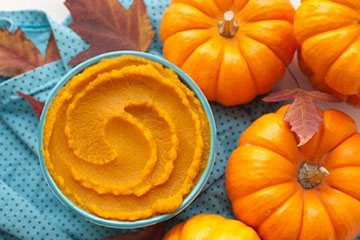
Pumpkin cut into pieces may become watery and will only be suitable for making creamy soup.
Therefore, in order to preserve the beneficial characteristics and culinary quality of the vegetable, you should not neglect the basic recommendations for the processing of preparations.
Reviews about pumpkin preparations
I freeze bars in single portions. It tastes the same as fresh, but it doesn’t look like it – it’s watery.
Nata
https://www.babyblog.ru/user/K_tya/3090039
They also froze at one time, raw - tasteless ((
Mishutka (Natasha+Misha=Moscow+Sevastopol)
https://www.babyblog.ru/user/K_tya/3090039
Definitely without skin! My mother-in-law once gave me a frozen one with the skin on. Be... You cook it, and then you scrape it off this skin... hot. Moreover, it’s a paradox - the child really likes pumpkin, but I’m already so tired of its smell that I don’t like to bother with it for a long time. Freeze without skin
Lena Mamaeva
https://eka-mama.ru/forum/part88/topic14304/message362696/
And I grind it in a food processor, it turns out almost puree, I put it in mayonnaise jars and freeze it. Then I cook porridge or make pancakes...
Aniram
https://eka-mama.ru/forum/part88/topic14304/message362696/
I cut it into cubes or grind it finely with a food processor and put it in the freezer, a lot at once... for the whole winter - into porridge, soup, sweet puree for children. everything is delicious!
Cherry
https://www.u-mama.ru/forum/family/cook/727710/
Cleaning
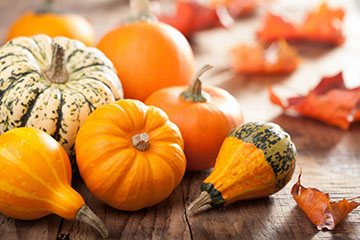
The pumpkin must be peeled from seeds and outer peel, divided into equal parts, which are then cut into small pieces.
So, it will be more convenient to use it.
To handle the thick and very tough peel, you will need a large kitchen knife and a cutting board.
After cutting the pumpkin into 2 parts, you need to remove the seeds from it.
What exactly is useful about it?
Pumpkin contains a huge amount of beta-carotene. There is more of it than in carrots. The orange color of the vegetable determines the amount of vitamin. The second name is vitamin A. Responsible for healthy vision and proper bone growth. Strengthens the immune system, activates resistance to viruses and bacteria.
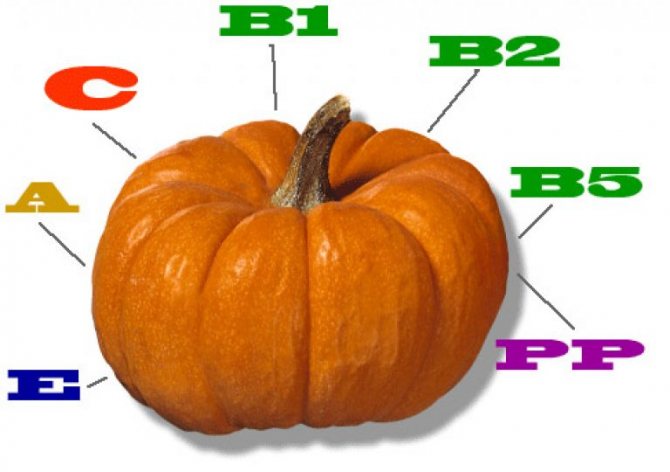
Pumpkin has a choleretic and diuretic effect, improves the functioning of the gastrointestinal system. It contains a lot of Potassium and Magnesium. Boiled and baked pumpkin is especially useful. This vegetable eliminates increased stomach acidity. Excellent for constipation and bloating.
Due to the fact that pumpkin is low in calories, it is used in dietary nutrition. It also has a beneficial effect on the nervous system, helps with insomnia and hyperreactivity.
Pumpkin contains a lot of vitamin C, which means it increases the body’s resistance to viruses and bacteria, and also makes the body stronger during illnesses. The vegetable does not cause allergies, so even small children suffering from rashes, eczema, and various rashes can eat it. It contains a lot of iron, so consuming it helps with anemia.
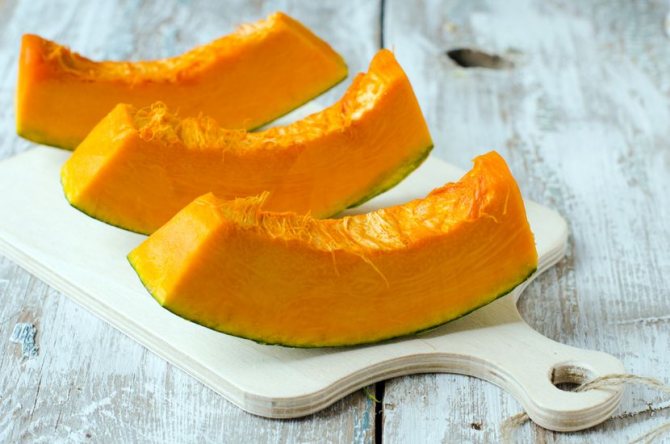
Freezing methods
As a puree
This method will take a little longer than others, but it's worth the effort. First, you will get rid of the snowiness and wateriness of the pumpkin by pre-baking it. Secondly, such a frozen semi-finished product without additional processing will allow you to prepare puree soup, casserole, porridge or pie in a matter of minutes. You simply take out the finished puree and add it to the desired dish. Thirdly, puree is much more compact compared to pieces, which means it will take up much less space in the freezer.
Pumpkin has a thick and tough skin, so have a large knife and cutting board ready.
- Cut the pumpkin in half and remove the seeds.
- Prepare puree from baked or boiled (see all methods below) pumpkin using a blender, masher or fork. The puree should be homogeneous, without lumps.
- Place the puree into prepared containers. Containers, plastic cups, and ice trays are suitable. To increase the shelf life of the semi-finished product and avoid weathering, choose molds with lids. Molds without lids can be wrapped in cling film, foil, or placed in a tightly tied plastic bag.
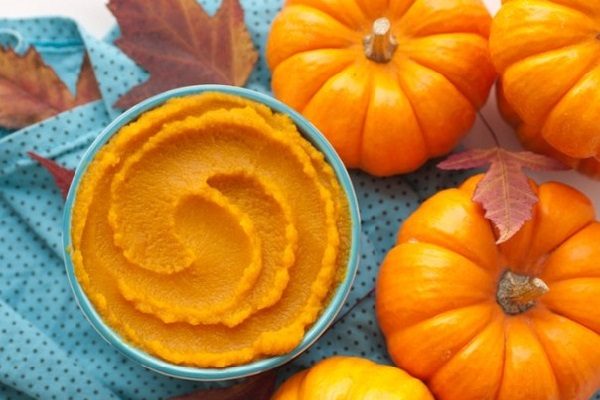
Pumpkin puree retains its beneficial properties when frozen
Choose the size of the mold depending on the dishes you plan to cook later. Ideally, the form should be portioned. For example, a 200 ml container is enough to make one pumpkin muffin.
Important: do not forget that when frozen, the puree expands, so leave a little free space and do not stuff the puree tightly under the lid.
Options for preparing pumpkin for puree:
- cleaned in the oven. Carefully remove the peel, cut the pulp into 3x3 cm cubes. Place them in one layer on a baking sheet and place in an oven preheated to 140° for 1 hour. Check the pumpkin for softness (it should be well kneaded with a fork), if necessary, keep in the oven for some more time;
- unpeeled in the oven. Cut the unpeeled pumpkin into 3 cm thick slices. Place on a baking sheet lined with parchment paper or foil in a single layer. Bake in a hot oven until the flesh is softened (about 1 hour). Cool the pumpkin and peel off the skin; it should easily separate from the pulp;
- in the microwave. Peel and cut the pumpkin into slices. Place in a microwave safe bowl and add some water. Microwave on high for 10-15 minutes. Repeat the procedure several times until the pumpkin is soft;
- boiled. Peel the pumpkin, cut into cubes, place in boiled water and boil until soft. The finished pumpkin should be easily pierced with a fork;
- for a couple. Place the peeled pumpkin, cut into small cubes, in a steam basket and place in a steamer with boiling water for 30–40 minutes. You can use a pressure cooker or a multicooker with a steam function.
Pumpkin frozen in the form of puree will be a convenient and healthy option for baby feeding. Keep in mind that the baked product has a concentrated taste and consistency, so when feeding a child (especially an infant), it is preferable to use boiled or steamed raw materials.
Preparation of pumpkin puree step by step - photo gallery
Raw pieces
Pumpkin puree is not suitable for all dishes. If you need pumpkin cubes or pieces, freeze them without pre-cooking them.
- Cut the peeled pumpkin into small pieces or slices.
- Dry with a paper towel.
- Spread in a single layer into a freezer container.
- Place in the top freezer at the lowest possible temperature.
- After a few hours, remove the frozen pumpkin, place it in a storage container with a lid (or bag) and place it in the freezer for long-term storage.
Freezing methods
To diversify your child’s diet with natural pumpkin dishes, it is convenient to store the fruit frozen. When properly frozen, the product does not lose its natural qualities and nutritional characteristics.
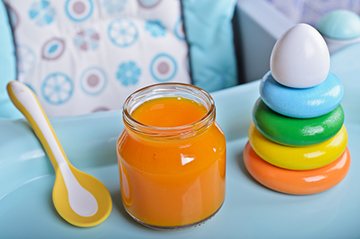
This freezing method takes longer than others, but it's worth it.
This method is guaranteed to get rid of the snowiness and wateriness of the pumpkin, since it is pre-baked.
Another plus is that once defrosted, the puree is easiest to use; it simply comes out of the refrigerator and is ready to use.
There are several options for preparing pumpkin for puree.
- Pumpkin cooked in the oven:
- The peeled pumpkin needs to be cut into cubes about 3*3 in size. The resulting cubes are laid out in one layer on a baking sheet. The pumpkin must be placed in the oven, preheated to 140 degrees for about 50 minutes until soft. This is the time needed to bake the pumpkin. You need to cook without adding water. You can check the softness of the pumpkin with a toothpick. If the toothpick sticks easily into the pumpkin, it is ready.
- The unpeeled pumpkin should also be cut into 3 cm slices and placed on a baking sheet lined with parchment paper or foil in one layer. The cooking time is the same as for peeled pumpkin. After cooking, cool the slices and peel the skins. When prepared correctly, it cleans easily.
- Pumpkin prepared in other ways:
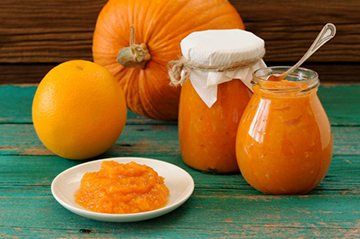
- The peeled pumpkin must be cut into slices, placed in a microwave-safe bowl and added a small amount of water. Prepares in the microwave for about 10-15 minutes.
- Boiled pumpkin. The vegetable must be cut into cubes and placed in boiling water, boiling until soft.
- Steamed pumpkin. Vegetables cut into cubes are placed in the steamer basket as soon as the water boils. Cooking time is about 30-40 minutes. You can also use a pressure cooker or multicooker with a steam function.
The finished pumpkin must be transferred to a bowl to make puree from the pumpkin in any convenient way.
This can be done using:
At the time of pureeing, you need to pour a little water to get the desired consistency. The puree should be thicker than what is fed to children. Thickness is needed so that when defrosting you can add more warm water, so the puree will defrost faster.
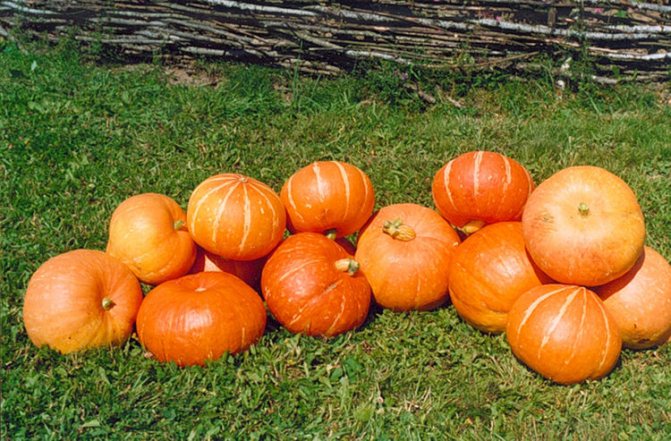
The finished puree must be cooled to room temperature and then, once cooled, divided into portions. It is recommended to use ice cube containers as they are small in volume. This is very convenient for defrosting a small amount of puree that the child eats. You can also use reusable plastic containers. They come in round, square, rectangular shapes.
To prevent the pumpkin from overheating, it is better to choose molds with lids or wrap the dishes with cling film, foil, or in extreme cases, simply place them in a tightly tied plastic bag.
It is best to prepare pumpkin for subsequent freezing in a double boiler. After all, such processing is considered the most useful way of cooking.
Cubes
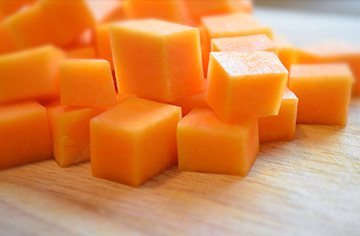
Proportions can be adjusted based on personal preferences. The pieces definitely need to be dried; excess moisture can be removed with a regular paper towel.
Once the pumpkin is cut, you need to grab a tray, board, or whatever goes into the freezer.
Cover them on top with cling film or a bag.
It is recommended to do this so that the pumpkin can be removed well later. It is optimal to lay it in approximately two layers. The tray must be placed in the freezer until the pumpkin is completely frozen.
Already frozen pumpkin must be placed in a plastic bag and tied tightly. You can even put it in two bags for safety. Next, the portions must be sent to the freezer for further storage. Cooking this way will prevent the pumpkin pieces from sticking to each other.
Grated pumpkin
The pumpkin can be chopped using a meat grinder with a vegetable attachment (with small holes) or simply grated.
It is recommended to transfer the crushed pumpkin mass into bags.
It is important to let the air out of the bags and close them tightly. Freezing this way saves space in the freezer. You can put 500 grams in bags.
